A potential love interest for Peter Parker was established in the last eight issues of Steve Ditko’s run on The Amazing Spider-Man. Peter began attending college in Amazing Spider-Man # 31 (Dec. 1965); a new setting called for new classmates, creating dramatic situations for the lead character. Ditko and Lee had not been communicating directly with each other for many months, but a change of such magnitude was almost certainly discussed far in advance. At this point Ditko was steering the ship, and once he began plotting the college stories he had ideas of his own. Perhaps to maintain continuity with the past, Ditko retained high school rival Flash Thompson, making him pals with newcomers Harry Osborn, a sneaky looking wise guy, clearly NOT intended to be likeable (Ditko would soon reveal that Harry was the son of another shady figure, Norman Osborn); and Gwen Stacy, an attractive, wide eyed blonde, described by Harry as “The ex-beauty queen of Standard High.”
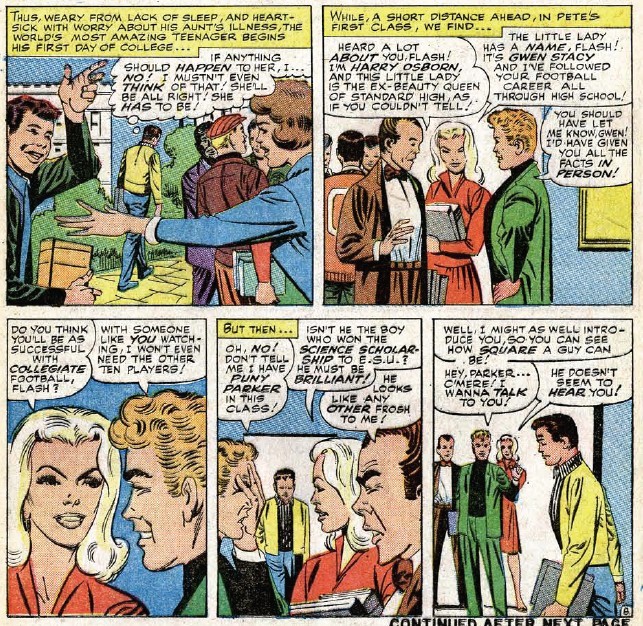
As the students convene, engaging in conversation, Flash notices Peter in the hallway and grudgingly calls him over for introductions. Aware of his academic background, Gwen takes an immediate interest in Peter, but, lost in thought and traumatized over his Aunt May’s illness, he fails to respond. Peter’s apparent snub leaves a poor first impression on the newcomers, who begin to believe Flash’s accounts. Soon after, Harry plays a prank on Peter, causing an explosion in the lab that gets him into trouble with the dean. While Harry, Flash and the other students are amused, Gwen is upset over their actions. Equally fascinated and confused over Peter’s behavior, Gwen’s ire is raised as well: she is not used to boys being inattentive to her charms (Gwen couldn’t possibly have considered Peter being gay under the rules of the Comics Code!). Ditko clearly had intentions for Gwen, making her the focal point in every college scene.
After a two issue hiatus, where Ditko completed his magnum opus (see my analysis of “The Lifting Sequence“), Gwen returned in Amazing Spider-Man # 34. With his Aunt out of danger, Peter finally takes notice of his beautiful colleague. He fords an opportunity to engage her when she drops a book, but Gwen stamps her foot down before he can retrieve it. Ditko uses his exceptional artistic talents to make Gwen’s expressions come alive, placing emphasis on her eyes. While Ditko has been accused of an inability to draw attractive women, he succeeds admirably with Gwen. While not beautiful in the classic sense, nor as perfectly formed as the later John Romita version, Ditko creates a sense of excitement and mystery with his character.
Gwen is again seen in Amazing Spider-Man # 36, chatting with Sally, a friend who also finds Peter attractive. Sally invites Peter to a party, and, while initially receptive, he backs off when she typecasts him as an intellectual. Gwen, observing the situation in the shadows, feels her attitude is confirmed. Later, Gwen bumps into Peter at a Space Exhibit, but sees him running off when a costumed criminal, the Looter, shows up to (what else?) loot the place. Thinking him a coward, Gwen again questions his actions. She later mocks Peter on campus, when he jokes with Flash about making him look bad on the football field.
Their next encounter takes place in the following issue, as Peter asks Gwen if he can walk her to class. Gwen sarcastically wonders why he now finds time to speak to her. Peter replies: “Well, at least I’m not a temperamental female who drools over a fella ONE day and then acts like an ICICLE the NEXT!”
While the language is characteristic of Lee’s conversational approach, Ditko’s sensibilities are defined by the image itself. Peter exudes an overwhelming sense of confidence, one that defined Ditko’s self-created characters. Lee gave his heroes a sense of vulnerability, adding a thought balloon to soften the impact of Ditko’s illustration:
“DRAT that lousy TEMPER of mine! Now I’ve REALLY put my foot in it!”
Gwen’s volatile temper erupts: she attempts to slap Peter, but he swiftly blocks her blow, as their hands touch. While outwardly hostile towards each other, Ditko adds a playful tension between the two. Surveying the scene, Flash confronts Peter, who nonchalantly walks away. Gwen finally sees past Peter’s façade, realizing he is not the least bit intimidated by Flash. Later, Gwen defends Peter when Harry badmouths him. As portrayed by Ditko, Gwen is not a woman who is easily fooled.
In Ditko’s final issue, Gwen, accompanied by Harry and Flash, looks on as a group of protesters confront Peter. While Ditko has the two appear in the same scenes, it is the only occasion where they do not interact. Ditko has Gwen exit the stage as she entered, intently studying Peter. The story could go no further Ditko had his bags packed, taking his ideas, concepts and future plans for Peter Parker and his supporting cast with him.
One can only speculate on the course Ditko would have taken the Gwen storyline, but judging by the printed work, her role would have been considerable. Peter’s romance with Betty Brant had reached a dead end; their paths diverged sharply over time. Betty was unable to accept the dangerous life Peter chose as a photographer, let alone a costumed adventurer. Ditko touched on the bittersweet emotions a breakup entailed, making it clear that a new relationship was in the offing.
There were other romantic possibilities for Peter. Liz Allan, a supporting character since the early days of the strip, was originally cast as the stereotypical “dumb blonde” who had a crush on Peter. Ditko presented a more serious side to her during the graduation sequence, where she expressed her feelings to Peter. Liz made a brief appearance in Amazing Spider-Man #30 (Nov. 1965), when Peter bumps into her on the street. Liz explains that she now has a job, asking Peter’s aid in avoiding Flash, who she has outgrown. Although Ditko did not have her attend college, a mature Liz could have figured into future stories. Finally, there was the ongoing, off-screen presence of Mary Jane Watson. Throughout Ditko’s run she remained an unseen “mystery woman” and a prospective blind date for Peter. Ditko enjoyed keeping readers guessing; he avoided showing Mary Jane’s face, although he eventually showcased her figure. The reaction of Flash, Betty and Liz accentuated the fact (and the joke) that the girl Peter kept avoiding was exceptional (Amazing Spider-Man # 25, June 1965). Mary Jane had a cameo at the end of Amazing Spider-Man # 38, just missing Peter. If Ditko had remained, this storyline would have had to be resolved, perhaps in a humorous fashion. Since Mary Jane was introduced early on in the feature, it’s conceivable that Lee and Ditko discussed long-range plans for her. Even so, Ditko would likely have deviated from Lee’s concept (and the version helmed by John Romita), perhaps making Mary Jane a hindrance to Peter.
A possible clue to Ditko’s plans for Gwen emerges four months after his last published Spider-Man story. While Ditko was working on Captain Atom for Charlton Press, he was given the go-ahead to rework a character that had been languishing for many years. The Blue Beetle initially appeared as a back-up feature in Captain Atom, plotted and drawn by Ditko. In the second installment (Captain Atom # 84, Feb. 1967), Tracey, scientist Ted Kord’s assistant/ girlfriend, is introduced. She is investigating the disappearance of Dan Garrett, the original Blue Beetle, unaware that Kord has taken over his costumed identity. Tracey is suspicious of Kord, as is a detective, who believes he is implicated in Garrett’s death. Traveling to Pago Island, where Garrett was last seen, Tracey confronts the Blue Beetle (Blue Beetle # 2, August 1967). When Tracy explains that she is trying to prove Garrett’s innocence, he sees the turmoil she is going through, and decides to unmask. Tracey accepts Kord’s life without hesitation, helping to clear his name.
Did Ditko incorporate his Gwen subplot into the Blue Beetle? Both their names (perhaps Ditko suggested Stacey or Tracey, in his notes to Lee, who altered the wording), as well as their appearance (both had long hair, one light, one dark) were similar. It’s conceivable that Gwen could have stumbled onto Peter’s secret. Why discard such a good idea when it could easily be shifted to a new strip, where Ditko had a clean slate to work with?
One truth is certain: Ditko’s Gwen Stacy would have differed considerably from what followed under Lee and Romita. Lee’s forte was in crafting soap-opera angst; romantic entanglements and misunderstandings, with the hero questioning his double life. Lee excelled in adding a layer of drama to his stories; Ditko was more pragmatic, insisting on a rational, adult hero–one who would seek out a like-minded companion. Under Ditko, Gwen could either have been a spoiled brat, causing trouble for Peter, or an intelligent woman who shared his values. While we will never know Ditko’s exact intentions for Gwen Stacy, the stories he plotted and drew point to an artist who orchestrated everything with intense deliberation, thought and reflection.
“Anything added to (or subtracted from) that which is already established needs to be considered and understood in regards to its long-range benefits and consequences.”
— Steve Ditko, A Mini-History, “Spider-Woman/Spider-Girl,” The Comics!, Vol 13, No 5, May 2002, Robin Snyder
Special thanks to Jacque Nodell. This article originally appeared in Ditkomania #79 and thanks to Rob Imes for letting us use it.
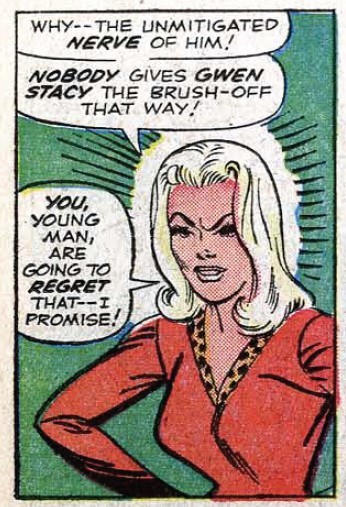


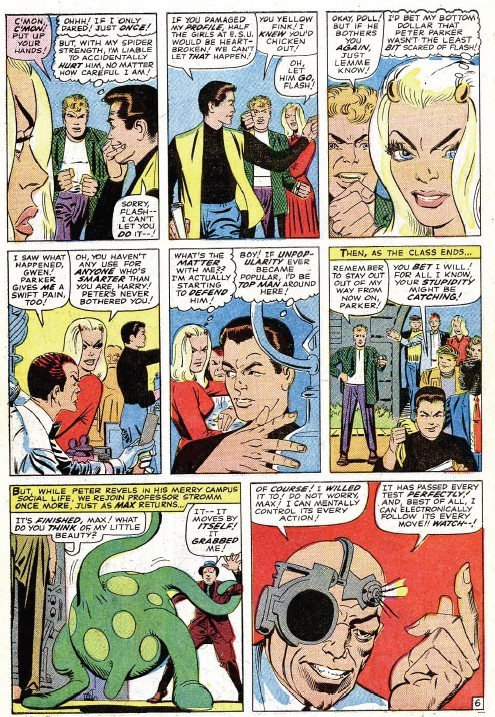
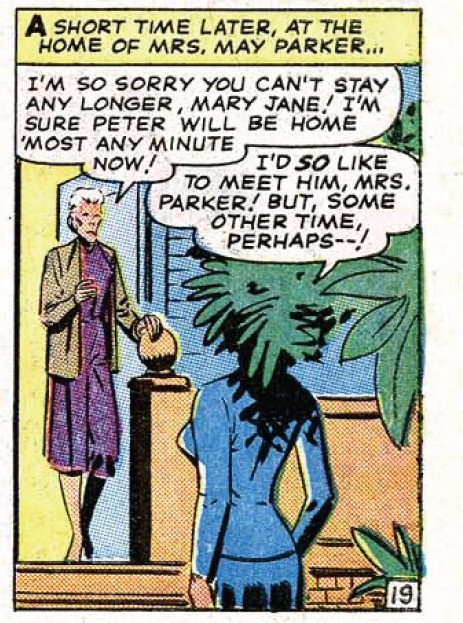
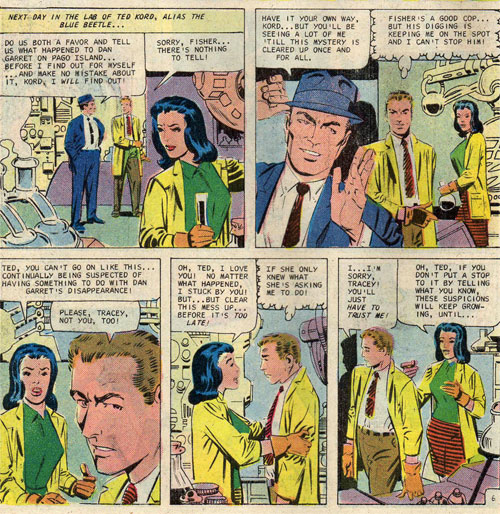
“Lee’s forte was in crafting soap-opera angst; romantic entanglements and misunderstandings, with the hero questioning his double life.”–This is a great summary of one of the things that made Lee’s run on Spider-Man so compelling, whether he was paired with Ditko or Romita; and of course he also used similar plotting tactics on other strips with other artists, but I think he was at his peak with it in the first 40 issues of Spider-Man. I think the high school/college setting enabled the romantic subplots to be developed more easily than, say, Don Blake’s hospital environment relationship with Jane Foster or Matt Murdock’s law office relatinship with Karen Page. There was more supporting cast to play with in Spider-Man, in an environment that lent itself to comic misunderstanding.
On Ditko’s side of it, as I’m looking at the art here I’m seeing his underlying roughs of Gwen as better than I remember his female figures on some other strips (for instance in his Tomb of Dracula b&w issues c. 1980 he drew some pretty unattractive women). However his inks don’t quite bring out the potential of some of the great poses he captures. I wonder what she would have looked like if another inker had gone over his roughs.
Hi Roy,
Thanks for putting my article up. The images you used were perfect. Lee really knew how to play up the romantic entaglements, and the high school environment and ensemble cast helped make the stories work. In regards to Ditko, while he certainly didn’t draw women as glamourously as Romita, John Buscema or Don Heck, his characters all had personality. Gwen was not unattractive under Ditko, but it would have been interesting to see someone like Wood ink her. Ditko could draw sexy women when he wanted to. Winnie the Witch, the hostess of Charlton’s Ghostly Haunts is one example.
Wood was great, that would be an interesting combination. Did he ever ink Dikto? I have some of Ditko’s Ghostly Haunts issues and I enjoy them (I’m holding #51 in my hand now and using the story “What She Sees in Him!?” as a reference while I type this), but I see some of the same tendencies with his female characters there that I see in his Marvel work. I think Dikto drew the female figure well–Winnie is certainly well-proportioned, as is Gwen–but he wasn’t as strong with hairstyles and facial subtleties on either men or women, and some of his tendencies with male characters became more problematic when he drew female heads and faces the same way he drew guys. His hair often looks flat, his noses tended to be flat or sharply pointy (which is fine for Harry Osborn or the Green Goblin, but a feminine nose needs to be rounder and fuller), and he inked eyebrows too thick for women (again, great for drawing JJJ, not so great for Betty or Liz or Gwen). Romita, as you note, was better at depicting glamor–his attention to women’s hairstyles and clothing styles is a good example of this. To be fair to Ditko I think most male artists who are used to emphasizing male anatomy have trouble with some of this type of thing unless they pay special attention to it–I’m harping on it because I’m trying to improve my own work in this respect–but in any case this is a difference I see between Ditko’s Gwen and the Gwen drawn by Romita. To expand a bit, I think Kane had some of the same issues drawing Gwen to a lesser degree–especially overshading her nose, though I think that was partly an inking issue–whereas Andru’s Gwen (in the clone storyline) is closer to Romita’s “glamous Gwendolyn.”
Roy,
Wood inked Ditko quite a few times: a number of stories in the 1960s for Tower comics; a four issue run of Stalker at DC in the 1970s and the Destructor for Seaboard/Atlas, plus a few others that slip my mind at the moment. Wood was an excellent inker and complimented Ditko. He also made his women more attractive.
Kane and Andru’s versions of Gwen, to my mind, also had sharp edges and needed Romita to tone that aspect down. John Buscema, however, drew women just as well as Romita.
Thanks for the information on the Ditko-Wood teamwork! I will need to find some of that. I remember that Wood drew women well in his work for EC. I agree on Buscema, he paid a lot of attention to correct anatomy while still capturing the Kirby “bigger than life” camera angles, which is one thing I liked about his work.
I don’t think Ditko’s Gwen Stacy was ugly. While she developing bizarrely arched eyebrows in future issues, as introduced she looked a lot like Charlize Theron (panel 3 in your clip from Amazing Spider-Man #31).
Roy, the Ditko-Wood Stalker is really nice stuff, displaying both artists’ styles without one overshadowing the other.
Thanks for the Ditko-Wood Stalker reference! From what you and Nick are saying about it, it sounds like I should get a piece with some samples from that up here. I think Gwen looks generally okay in the panels sampled here. Like I mentioned, I was surprised how good the roughs were when looking at these panels again (I’ve read these issues many times but uploading them online when I was posting this piece for Nick was a different experience because I was focusing on them and seeing them at a different size than I’m used to). The main inking adjustments I think might have improved Gwen here would be a lighter touch on the eyebrows and a de-emphasis on those hair barrettes she has in these panels.